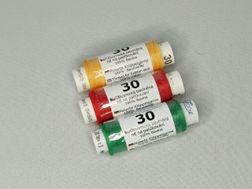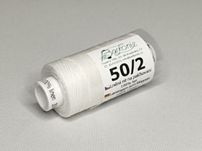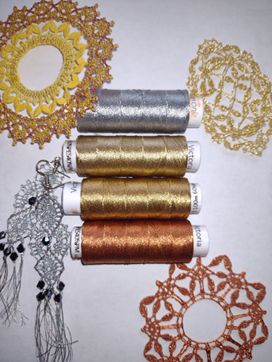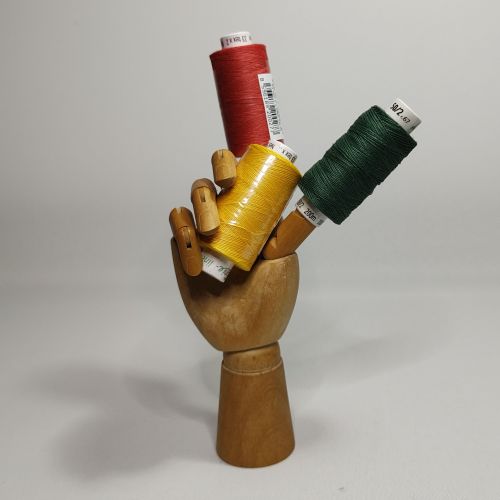When I started bobbin lace 30 years ago, we used pearl thread, snowdrop thread and cordonet. Many times it was archive threads from “grandmother”. They often broke, lost color and individual skeins separated. In Prague they had special threads for bobbin lace. They were colorful, had different thicknesses, structures and compositions. Working with them was incomparably better. Now you can find them, for example, at lace festivals.
But how do you navigate the different names and numbers? How do you know that the thread you paid a few euros for is really suitable for what you want to use it for?
Material
We use mostly natural yarns: linen, cotton, hemp, wool, silk...
Cotton is smooth and can withstand high temperatures when ironing, and it hardens well with various hardeners. Not all threads and yarns are colorfast, especially shades of red and purple are problematic.
Cotton threads come in different thicknesses. The thickness of the thread is given as tex or Nm. TEX indicates the weight of the thread (grams per kilometer, or milligrams per meter). The higher the TEX of the thread, the stronger the thread. If the Tex is not stated on the thread, there is always the length of the winding and the weight, so you can calculate it. For bobbin threads, commercial numbering is also used: 0, 30, 50... The higher this number, the finer the thread. 0 is the thickest, 8 is like pearl thread. Thickness 0 is used as braiding, 8-30 for multi-pair torchon lace, 50 and more for tulle lace. For strip lace, choose the thickness according to the width of the strip you want to make. Most often 8-30. Thinner threads make a strip very laborious.

Cotton threads are known as shoemaking (ON) and mercerized (MA). Shoemaking is stronger, has a lower sheen. Use it for bobbin lace, small decorations, jewelry, and multi-pair lace.
They are easier to work with. They are suitable for bobbin lace, small decorations, multi-pair lace, but especially ribbon lace. You will enjoy them especially where you need to create a feeling of fullness of lace.
Floss and pearl floss are also cotton. You can also divide the floss into individual threads and use them to make bobbins. The entire skein is used as a braid.
For pictures and small decorations, choose threads around size 30. Also try using threads in the same color but different thicknesses.

Linen is more structured, the threads are not quite smooth. The shades are more muted and natural. It is also available in a polished finish, known as button thread (42 tex 3 (NeL 39.7/3, Nm 24/3).
Linen threads are suitable for bobbin paintings, small decorations, multi-pair lace, ribbon lace. The structure can also be used in clothing lace.
Linen is 50/2, similar to cotton 30, 50/4 pearl. Linen threads and yarns are also available in thicker versions, more suitable for clothing lace.
Hemp is harder to find, the color range is limited, it is mostly thicker threads. They were mainly used for ribbon lace.
Wool is thicker, can have different shades and structure. In multi-pair lace it is used as a braid, or clothing parts are bobbined with it. Felt threads can also be bobbined.
Silk is usually thinner, shiny. Working with it is more difficult, it is slippery. It is necessary to follow the maximum ironing temperature and other instructions for maintaining lace made from such thread. It is suitable for small decorations, jewelry, finishing ribbon lace and is widely used in clothing lace.
Recently, artificial fibers or mixed threads have also been used.
Andrea threads are a combination of 100% Egyptian long-staple cotton and a metallic polyester strip that gives the thread shine. They come in three thicknesses: Andrea 10, 12 and thin 55. The strength of the threads is comparable to cotton with a given number.
Metallic threads

Victoria
Victoria threads are a replacement for REXANA threads. It is very easy to spool, it is pliable and holds its shape nicely. It can also be embroidered with and is also suitable for machine embroidery. The thickness is between 12 -15. It has 4 colors: Silver, light gold and dark gold, copper). If you use it 2 times, it makes a nice braid.
DMC Diamont is similar to Victoria.
Karolina
A replacement for REXETA and TILEKO, it has several subtleties. Karolina 1 is universal, which consists of 1 skein (Karolina 2 has 2, 3 three, 5 five). It can be used alone or in combination with cotton (for example, cotton 50-60). For bobbins, thicknesses 3 and 5 are very hard, they can only be used as an insert thread. They produce it in 29 shades.
Elisabeth
It is visually similar to wire. Reach for it when you want to make a replica of metal lace. It has 3 thicknesses (1,2,3) and comes in only 2 colors - gold and silver. Elisabeth 1 is a replacement for Titolo. The thickest Elisabeth is a replacement for Titano and is about as thick as pearl thread. It is only suitable as a braid, or to reinforce lace instead of wire.
Artificial silk (silk cordonet) is used as a substitute for silk. It is not easy to work with and is therefore mainly used as an interlining thread or to decorate lace with leafs.
Thicker yarns (e.g. Anchor, YarnArt) are currently popular as braiding yarns.
Gympa, wire and other materials
You can also use wire, paper strips, bast, leather...

If you use wire, expect it to corrode over time. Touch it as little as possible, use special wire chopsticks, and don't heat the finished product.
Gympa is a wire coated with artificial silk or metallic ribbon. It does not corrode as quickly. It is used in the edges of lace to reinforce it, or as an inserted thread.
Paper twine, bast, straw, feathers, and beads also find use in modern lace.



